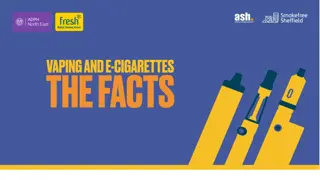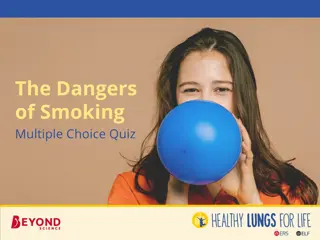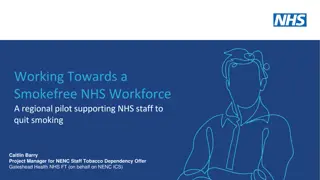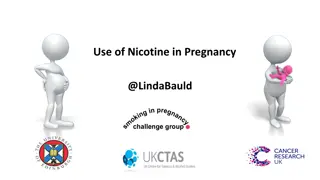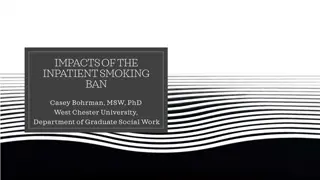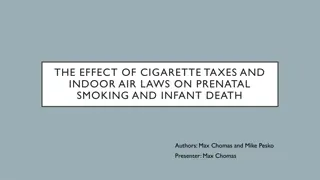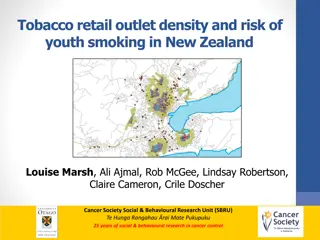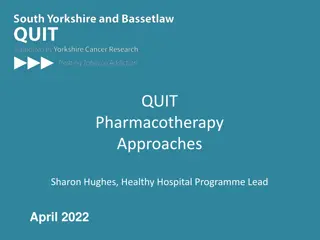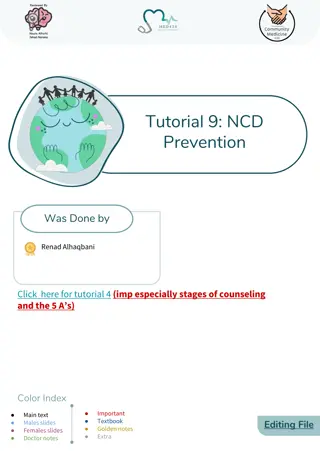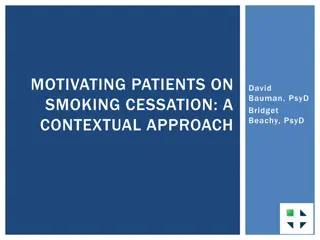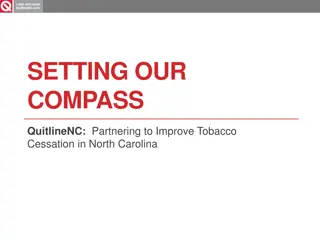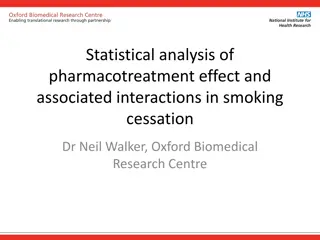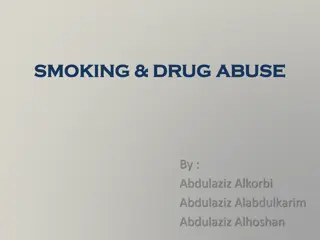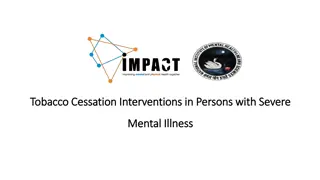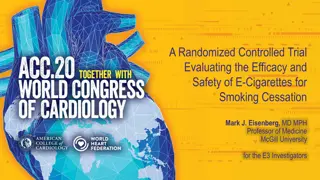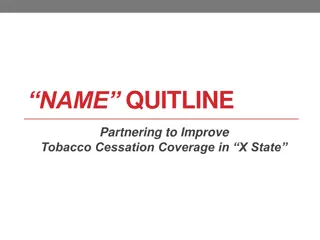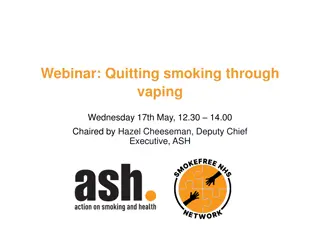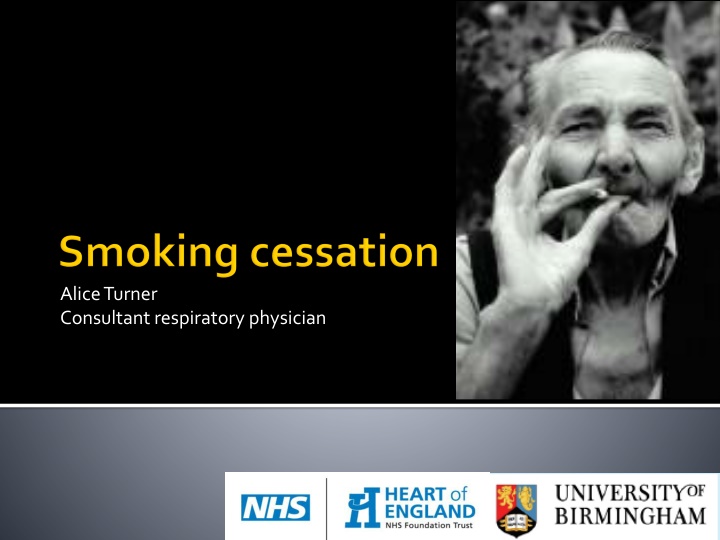
Smoking Cessation and its Impact on Health
Explore the benefits of smoking cessation and methods to quit smoking effectively. Learn about the prevalence of smoking in Great Britain and the challenges smokers face when trying to quit. Discover the lifetime probability of remission from nicotine dependence and smoking withdrawal symptoms. Empower yourself with valuable insights for a smoke-free life.
Download Presentation

Please find below an Image/Link to download the presentation.
The content on the website is provided AS IS for your information and personal use only. It may not be sold, licensed, or shared on other websites without obtaining consent from the author. If you encounter any issues during the download, it is possible that the publisher has removed the file from their server.
You are allowed to download the files provided on this website for personal or commercial use, subject to the condition that they are used lawfully. All files are the property of their respective owners.
The content on the website is provided AS IS for your information and personal use only. It may not be sold, licensed, or shared on other websites without obtaining consent from the author.
E N D
Presentation Transcript
Alice Turner Consultant respiratory physician
Background Benefits of smoking cessation Methods of smoking cessation Smoking cessation and COPD
Approximately 10 million adults in Great Britain smoke cigarettes1 24% Regional prevalence2,3 National prevalence Target smoking cessation prevalence 21% 26% 25% Scotland 24%2 22% by 20104 23% Wales 21%2 13% 17% range5 20% 20% 19% England 21%2 10% or less by 20206 21% 19% 20% Northern Ireland 26%3 21% by 20117 21% 1. ASH Facts at a Glance: Smoking Statistics. www.ash.org.uk/files/documents/ASH_93.pdf. 2. Smoking and Drinking Among Adults. (2008). www.statistics.gov.uk/downloads/theme_compendia/GLF08/GLFSmoking&DrinkingAmongAdults2008.pdf 3. Space to Breathe. Smoking facts. www.spacetobreathe.org.uk/article.asp?aid=199. 4. Scottish Government (2008). Health of Scotland s Population Smoking. www.scotland.gov.uk/Topics/Statistics/Browse/Health/TrendSmoking 5. Chief Medical Officer for Wales Annual Report 2009. http://wales.gov.uk/topics/health/ocmo/publications/annual/report09/?lang=en. 6. Department of Health (2010). A Smokefree Future. www.dh.gov.uk/en/Publicationsand statistics/Publications/PublicationsPolicyAndGuidance/DH_111749.. 7. Department of Health (2008). Priorities for Action 2008 09.
Lifetime probability of remission from dependence1 Nicotine 83.7% Alcohol 90.6% Cannabis 97.2% Cocaine 99.2% 1 Lopez-Quintero et al, Addiction (2011) 106: 657-69
The majority of smokers want to quit1 Most people try to quit without any assistance2 Only 3 5% of unaided quitters remain smoke-free after 6 to 12 months3 Most smokers make five to seven attempts before they finally succeed3 98% of smokers who relapse following a quit attempt are willing to try quitting again4 1. Boyle P et al.Eur J Public Health 2000; 10 (3 Supplement): 5 14. 2. Jarvis MJ. BMJ 2004; 328: 277 279. 3. Hughes JR et al. Addiction 2004; 99: 29 38. 4. Joseph A et al. Nicotine Tob Res 2004; 6: 1075 1077.
Smoking withdrawal symptoms Nicotine withdrawal produces a range of effects, including depressed mood1,2 Effects last from a few days to a couple of weeks1,2 Duration Symptom Prevalence <1 week Night time waking 25% <2 weeks Poor concentration 60% >2 weeks Urges to smoke 70% <4 weeks Irritability Restlessness Depression 50%-60% >10 weeks Increased appetite 70% 1. McEwan A et al (2006). Manual of Smoking Cessation. A Guide for Counsellors and Practitioners. 2. American Psychiatric Association (2000). Diagnostic and Statistical Manual of Mental Disorders Fourth Edition Text Revision.
Time Effect 24 hours BP and heart rate improve 1 year MI risk halves 5-15 years IHD & CVD risk equal to never smokers Lung Health Study mortality 45%2 Smoking bans3 MI 17% - mean of all time points Effects greatest in younger patients 26% decrease each year after implementation 1 US DOH, Report of surgeon general (1990) 2 Anthonisen et al, AJRCCM (2002) 166: 333-9 3 Meyers et al, J Am Coll Cardio (2009) 54: 124-55
PAR (%) N studies Ref Cancer type OR in smokers Duration of risk Iodice et al, Lang Surg Rev (2008) Pancreatic 1.74 10 years 20 82 Zeegers et al, Cancer (2000) Urinary tract 3.33 - 50/33 43 Yu et al, Lung Cancer (1996) Squamous lung 2.03 50% at 10 years 65/53 15 Tramacere et al, Epidemiology (2011) Upper GI 1.85 14 years - 33 Hamajima et al, Br J Cancer (2002). Breast 1.03 - - 53 After diagnosis of early stage lung cancer, continued smokers are much more likely to die1 OR 1.86 (1.33-2.59) 33% 5 year survival in smokers v 70% in quitters 1 Parsons et al, BMJ (2010) 340: b5569
Reduces FEV1 decline1 Reduces hospitalisations in COPD1 Reduces mortality in COPD1 Improves asthma symptoms & QOL2,3 Reduces mortality due to CAP4 1 Anthonisen et al, JAMA (1994) 272: 1497-505 2 Jang et al, All Asthma Immunol Res (2010) 2: 254-9 3 Tonneson et al, Nicotine Tob Res (2005) 7: 139-48 4 Inoue et al, J Epidemiol (2007) 17: 194-202
Trend to lower risk of complications, especially pulmonary in people who quit Largely benefits accrue after 2/52 or more Myers et al, Arch Intern Med (2011) 171: 983-
Current smoking risk of 1 Alzheimers Vascular dementia Other dementias Current smoking risk of cognitive decline2 Global cognition score -0.09 (-0.15- -0.03) Effects twice as big when deaths/dropout excl Effects of past smoking unclear, but appears that effects level out once quit for 10 years 1 Peters et al, BMC Geriatr (2008) 8: 36 2 Sabia et al , Arch Gen Psych (2012) Epub ahead of print
Reduces pre-term birth Reduces low birthweight Average gain 52g Lumley et al, Cochrane (2009) CD001055
Weight gain 5kg in first year 8% in women, 6% in men Wise et al, AJRCCM (1998) 157: 866-72
Quitters decline slower effect most marked in Quit before 30 & FEV1 decline is same as if never smoked. Quit after 40 rate no diff from continuous smokers?2 1 1 Anthonisen et al, JAMA (1994) 272: 1497-505 2 Konhansal et al, AJRCCM (2009) 180: 3-10
Most effective interventions combine pharmacotherapy with behavioural support Long-term quit rates are highest with a combination of pharmacotherapy and behavioural support1 Cochrane grade A evidence2 Simple advice from a physician can have a small but significant effect on smoking cessation. Advice and/or counselling given by nurses also significantly increase the likelihood of quitting Behavioural therapy Brief advice No treatment Medication 30% 20% 10% No medication 15% 10% 5% 1. Hughes JR et al. CA Cancer J Clin 2000; 50: 143 151. 2. DOH Guidance 20010/11. www.dh.gov.uk/prod _consum_dh/groups/dh.digitalassets/@dh/@en/@ps/@sta/@perf/documents /digitalasset/dh_109889.pdf.
Individual Group Web-based Meta-analysis suggests effective1 Intensity of support May not make a difference2 Group better than one to one3 1 Myung et al, Arch Intern Med (2009) 169: 929-37 2 Stead et al, Cochrane (2008) CD000146 3 Bauld et al, J Public Health (2010) 32: 71-82
Nicotine replacement therapy (NRT) Bupropion (and other antidepressants) Varenicline (and other partial agonists)
NRT type OR of quitting 95% CI Number of trials All 1.58 1.50-1.66 108 Patch Spray 1.66 2.02 1.53-1.81 1.49-3.73 41 4 Gum 1.43 1.33-1.53 53 Inhaler 1.90 1.36-2.67 6 Lozenges/tablets 2.00 1.63-2.45 4 Stead et al, Cochrane review (2008) CD000146
Work out the dose they need from the amount smoked <10/day Medium strength patch (10mg) 2mg gum prn or 10mg cartridges for inhalator >10/day High strength patch (15mg) May need to use 4mg gum prn or 15mg inhalator
Drug Bupropion OR of quitting 95% CI 1.69 N trials 36 1.53-1.85 Nortriptyline 2.03 1.48-2.79 6 SSRI 0.92* 0.68-1.24 6 MAOI 1.49* 0.92-2.41 4 Venlafaxine 1.22 0.64-2.32 1 Adding bupropion or nortriptyline to NRT do not provide additional benefit * OR for paroxetine (n=4 trials) and selegiline (n=3) Hughes et al, Cochrane (2011) CD000031
Start 1-2/52 pre cessation 150mg od for 6 days then bd for up to 7/52 Dose reductions with age, liver and renal disease
Start 1-2/52 pre cessation 150mcg od for 3/7, then bd for 4/7 1mg bd for 11/52 thereafter Course can be repeated if needed Dose reduction if eGFR <30
Works better than placebo, most trials are varencline NNT= 10 Cahill et al, Cochrane review (2011) CD006103
Case reports of pre-existing psychiatric disease worsening, but remains a caution Trial data did not show this Not in age <18 or pregnancy Reduce dose in severe renal impairment
NS diff between groups for all except sleep, which was worse with placebo Tonstad et al, Drug Saf (2010) 33: 289-300
NRT Bupropion or nortriptyline Ongoing studies of varenicline suggest likely to be safe, but most are retrospective
Varenicline v placebo in COPD Varenicline v placebo, 12 weeks, smokers with mild to moderate COPD; n=504 1.Tashkin DP et al. Chest 2011; 139: 591 599.
Secondary endpoint: Continuous abstinence 52 weeks Primary endpoint: Continuous abstinence rate last 4 weeks of treatment
9/52 and 1 year quit rates N= 10251 and n= 10272 Pooled data OR 1.85 and 1.593 1. Gonzales D et al. JAMA 2006; 296: 47 55. 2. Jorenby DE et al. JAMA 2006; 296: 56 63. 3. Nides M et al. Am J Health Behav 2008; 32: 664 675
NNT v placebo 23 (95% CI 20 27) 18 (95% CI 14 23) 10 (95% CI 7 14) All types of NRT Bupropion Varenicline Meta-analysis of all RCTs that followed up for at least 6/12 Total numbers studied = 10300 1. Cahill K et al. Cochrane Database of Systematic Reviews 2008, CD006103.
Cost per QALY NHS will consider is 20000 Above is equivalent to 3018-6415 Wu & Sin, Int J COPD (2011) 6: 259-67
18000 Minimal counselling Quit rates 1.4% for usual care 2.6% for minimal 6.0% for intensive 12.3% counselling + pharmacotherapy If 50% patients quit, effects at 25 years Cost per QALY = 1982-13960 16000 14000 Intensive counselling Cost per QALY ( ) 12000 10000 Counselling + pharmacotherapy 8000 6000 4000 2000 0 Hoogendoorn M et al. Thorax 2010;65:711-718
Smoking cessation is beneficial COPD patients benefit most Most forms of NRT work the same Varenicline may work better but costs more

